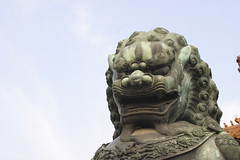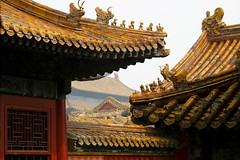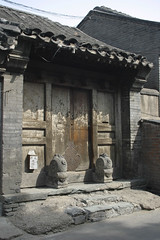So as soon as the new video ready iPod [apple.com]—I’ll take two please, black!—came out the ‘video podcast was on. So how long before iPorn or porncasts? Weekly subscriptions to a 10, 20 or 30 minute video of for favorite girl or fetish? Can I patent this idea?
Washington, DC, USA — July 2005
In the more pictures that I have neglected to upload you can now find these photos from Washington DC (and Arlington VA.) This photos were taken when Candice and I were in DC at the end of August.
Nothing spectacular here but a few nice shots of Arlington National Cemetery [wikipedia.org] and of the Vietnam Veterans Memorial [wikipedia.org]. There are also a few nice Flower pictures. Enjoy
steal these photos!
S██████ just pointed out to me that someone is using one of my photos from flickr [flickr.com] on their website. Of course there is nothing wrong with this. I list all my flickr photos under the Creative Commons [creativecommons.org] Attribution [creativecommons.org] license. So anyone is welcome to use them. I actually think it’s kinda cool that someone is using a pic. (This pic in question is here [flickr.com] and the website using it (currently) is ova’ he’re [metamonkey.net])
Sweet Jebus! I’ve been published on the web! As a photographer!
Coming (back) to America
Events beyond my control (and people beyond my ability to smite) have compled me to head back to the US for a few weeks to work with some guys there. I don’t actually expect to have much time to do anything but maybe I can catch up and have dinner with some people I missed last trip.
Beijing, China — September 2005
The first thing you notice about Beijing (aside from ‘there’s a billion Chinese people here!’) is the smog. I’ve read about the smog and I’ve seen pictures of the smog, but trust me, it’s worse than all that. After walking around for just 30 minutes you become covered in a fine layer of grit. Just rubbing your hand across your forehead is like using one of those facial washes with ‘micro beads.’ I know that Mexico City has a serious smog problem, but I can’t imagine much worse than Beijing, walking down the street and breathing is akin to being in a smoky pub. Mexico City’s problem is compounded because the city sits in a bowl and the wind can’t blow the smog away. Beijing is on an open plain and visibility was often less than 2 miles.
After you make it past the smog—and how frustrating the fog makes photography!—Beijing is an interesting city. Like Bangkok [confusion.cc] and Kuala Lumpur [confusion.cc] Beijing has thoroughly westernized sections filled with billboards, shopping malls, traffic jams, fast food and typical consumerism (only everything is well, Chinafied). Knock-offs are, of course, everywhere in this communist consumer wonderland but there are a lot of genuine western products mixed in. Other parts of Beijing are more like Ho Chi Minh [confusion.cc], they are still recovering from their enforced isolation from the forces of globalization, but you can still get your McMao burger—you just have to walk further.
The big touristy attractions of The Forbidden City (紫禁城 / zǐ jìn chéng) [wikipedia.org], the Summer Palace (颐和园/頤和園 / Yíhé Yuán) [wikipedia.org], the Temple of Heaven (天壇 / Tiān Tán) [wikipedia.org] are a must. They are tightly controlled, you have to pay entrance fees and often you have to pay again for specific parts (or make sure you get the ‘inclusive’ ticket at the main gate) and everything seems to close early—5:00 or 5:30. I guess that’s socialist work hours and communist work hours have something in common. The Summer Palace and Forbidden City merit all day if you don’t get burned out, and the Temple of Heaven and surrounding park and building can kill most of a day too.
For a bit more local color—and, watch out, smell!—the hutongs [wikipedia.org] that surround the city center are the place to head to. There are so many layers of living history in the maze of hutongs. From shops selling Mao buttons and patches, to fantastic noodle shops, barbers in the street, and local markets, every corner turned presents a new character. The classic hutongs of Beijing are disappearing but the large number of new ‘public toilets’ that I saw seems to me to indicate that the government has admitted that they won’t be able to wipe them out before the 2008 Summer Olympics [beijing-2008.org]. It’s both disturbing and fascinating to see people living in (basically) the same style and buildings that their ancestors lived in 800 years ago. I think I saw the source of some of that grit in the air while Candice and I explored the hutongs Southwest of the Forbidden City; a man on a flat bed bike delivering charcoal briquettes for cooking.
Of course half (at least) of the reason for going to Beijing was to see the Great Wall of China [wikipedia.org]. With a little help from a colleague at work who lived in Beijing for a time and the Lonely Planet [lonelyplanet.com] Beijing [lonelyplanet.com] guide book, I decided to avoid the touristy and totally rebuilt section of wall at Badaling (八達嶺 / Bādá Lǐng) [wikipedia.org] and hike the 10 or so kilometers between Jinshanling and Simatai (sorry no links on Wikipedia).
The hike was great. The 10 or so kilometers between Jinshanling and Simatai becomes about 12 by the time you hike up to the wall and back down. We started at 6:30 in the morning and there were already people on the wall. I was fairly certain we would be the first at the Jinshanling end as we woke the ticket collector up. I wanted to be on the wall for sun rise but a miscommunication somewhere along the line while booking the ride ended up causing us to miss sunrise by 40 minutes or so (that after getting up at 3:30 and leaving at 4:30—Jinshanling is ~110km from Beijing.) But it was still beautiful.
The hike is fairly easy when you get up to the wall at Jinshanling, but that’s misleading as a the first kilometer or so has been restored for the tourist taking the cable car up and hiking back down to the parking lot. After you pass the guard tower that is the end point for the cable car the wall undergoes a sudden shift from easy well maintained to not maintained since the Ming Dynasty. The means the wall is in various stages that range from a little weathered to no side walls, bricks reduced to gravel, to almost no wall. The steps are steep and uneven, when there are steps, and in some places you need both hands free for climbing. It can be quite harrowing on the sections with no side walls to keep you from falling and a smooth 60 degree downward slop.
In the end we made it with only sore feet and ankles and bit of a sun burn (I left the sun screen on the bed in the hotel – d’oh!) but it did take us 6 hours. I took hundreds of photos, and even at the wall—110+ km from Beijing the smog was a problem. I took photo after photo because I don’t think I will ever be back to that section of wall. I might, if I’m lucky, do part of the Great Wall again one day but if the choice was mine I would visit a section I did not see this time.
The Great Wall is one of the places near the top of my must see list of historical sites. The Acropolis in Athens [wikipedia.org], Stonehenge [wikipedia.org], the Great Pyramid of Giza [wikipedia.org], Angkor Wat [wikipedia.org], and the Taj Mahal are the others [wikipedia.org]. I’ve done three now, three to go. Hopefully I can do Angkor Wat and the Taj Mahal while I am living on this side of the world.
All in all Beijing was a great trip. Too short by far, but a great trip. Between all the touristy things I got to see a lot of everyday life—flying kits in the part, shopping at the market, road side noodle shops. I didn’t get to see anyone doing Tai Chi or other martial arts but maybe next trip to China.





